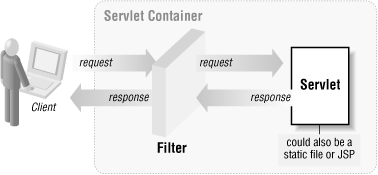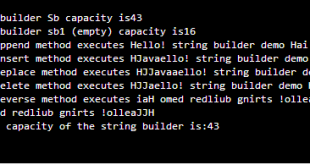Servlet Filters:
If you are a beginner in web application programming, then you have a doubt however the user unless logged in to the account access the resources. Most of the beginners don’t know how solve this problem.This is avoided by using . The basic functionality of the servlet filter is filtering the request from the user and allow the access to requested resources. A filter is an object that performs filtering tasks on either the request to a resource (a servlet or static content), or on the response from a resource, or both. Filters perform filtering in the doFilter method. Filters are configured in deployment descriptor file. (web,xml) file. Filter is a class introduced from servlet2.3 onwards. Controller first reaches the filter then passes to other resources. Filters are loosely coupled with the target. (Means, the filter can change without effecting the any other changes in the code.) Basic filters are: 1) Authentication Filters 2) Logging and Auditing Filters 3) Image conversion Filters 4) Data compression Filters 5) Encryption Filters 6) Tokenizing Filters 7) Filters that trigger resource access events 8) XSL/T filters 9) Mime-type chain Filter Filter enabling in web.xml file For a specific jsp page use *.jsp For every request use /* For a specific jsp page use nameofjsp.jsp We enable filter functionality by using @WebFilter annotation. We can create any number of web filters. init public void init(FilterConfig filterConfig) throws ServletException Called by the web container to indicate to a filter that it is being placed into service. The servlet container calls the init method exactly once after instantiating the filter. The init method must complete successfully before the filter is asked to do any filtering work. The web container cannot place the filter into service if the init method either Throws: ServletException The doFilter method of the Filter is called by the container each time a request/response pair is passed through the chain due to a client request for a resource at the end of the chain. The FilterChain passed in to this method allows the Filter to pass on the request and response to the next entity in the chain. A typical implementation of this method would follow the following pattern:- Throws: java.io.IOException ServletException destroy public void destroy() Called by the web container to indicate to a filter that it is being taken out of service. This method is only called once all threads within the filter’s doFilter method have exited or after a timeout period has passed. After the web container calls this method, it will not call the doFilter method again on this instance of the filter. This method gives the filter an opportunity to clean up any resources that are being held (for example, memory, file handles, threads) and make sure that any persistent state is synchronized with the filter’s current state in memory. FilterChain is an interface used to invoke next filter in the chain. See the below example: package Filter; import java.io.IOException; /** /** /** /** // pass the request along the filter chain /** } Configuring the To configure
Methods in Filter Interface:
1.Throws a ServletException
2.Does not return within a time period defined by the web container
doFilter public void doFilter(ServletRequest request,ServletResponse response,FilterChain chain)throws java.io.IOException,ServletException
1. Examine the request
2. Optionally wrap the request object with a custom implementation to filter content or headers for input filtering
3. Optionally wrap the response object with a custom implementation to filter content or headers for output filtering
4. a) Either invoke the next entity in the chain using the FilterChain object (chain.doFilter()),
4. b) or not pass on the request/response pair to the next entity in the filter chain to block the request processing
5. Directly set headers on the response after invocation of the next entity in the filter chain.
void destroy()
Called by the web container to indicate to a filter that it is being taken out of service.
void doFilter(ServletRequest request, ServletResponse response, FilterChain chain)
The doFilter method of the Filter is called by the container each time a request/response pair is passed through the chain due to a client request for a resource at the end of the chain.
void init(FilterConfig filterConfig)
Called by the web container to indicate to a filter that it is being placed into service.
Create a Filter in your web project right click on project and select others, in that select Filter.
import javax.servlet.Filter;
import javax.servlet.FilterChain;
import javax.servlet.FilterConfig;
import javax.servlet.ServletException;
import javax.servlet.ServletRequest;
import javax.servlet.ServletResponse;
import javax.servlet.annotation.WebFilter;
* Servlet Filter implementation class FilterDemo
*/
@WebFilter(“/FilterDemo”)
public class FilterDemo implements Filter {
* Default constructor.
*/
public FilterDemo() {
// TODO Auto-generated constructor stub
}
* @see Filter#destroy()
*/
public void destroy() {
// TODO Auto-generated method stub
}
* @see Filter#doFilter(ServletRequest, ServletResponse, FilterChain)
*/
public void doFilter(ServletRequest request, ServletResponse response, FilterChain chain) throws IOException, ServletException {
// TODO Auto-generated method stub
// place your code here
System.out.println(request.getRemoteHost());
chain.doFilter(request, response);
}
* @see Filter#init(FilterConfig)
*/
public void init(FilterConfig fConfig) throws ServletException {
// TODO Auto-generated method stub
}
filters in web.xml file:
a filter:
web.xml deployment descriptor in a text
editor or use the Administration Console. The web.xml file is located in the WEB-INF directory of your Web
application.
declaration. The <filter> element declares a filter,
defines a name for the filter, and specifies the Java class that executes
the filter. The <filter> element must directly follow the
<context-param> element and directly precede the
<listener> and <servlet> elements. For example:<context-param>Param</context-param><filter> <icon> <small-icon>MySmallIcon.gif</small-icon> <large-icon>MyLargeIcon.gif</large-icon> </icon> <filter-name>myFilter</filter-name> <display-name>My Filter</display-name> <description>This is my filter</description> <filter-class>examples.myFilterClass</filter-class> </filter><listener>Listener</listener><servlet>Servlet</servlet><filter> <icon> <small-icon>MySmallIcon.gif</small-icon> <large-icon>MyLargeIcon.gif</large-icon> </icon> <filter-name>myFilter</filter-name> <display-name>My Filter</display-name> <description>This is my filter</description> <filter-class>examples.myFilterClass</filter-class> <init-param> <param-name>myInitParam</param-name> <param-value>myInitParamValue</param-value> </init-param> </filter>
- To create a
filter mapping using a URL pattern, specify the name of the filter and a
URL pattern. For example, the followingfilter-mappingmapsmyFilterto
requests that contain/myPattern/.
<filter-mapping><filter-name>myFilter</filter-name><url-pattern>/myPattern/*</url-pattern></filter-mapping>
<filter-mapping><filter-name>myFilter</filter-name><servlet-hame>myServlet</servlet-name></filter-mapping>
Configuring a Chain of Filters
WebLogic Server creates a chain of filters by creating a list of all the filter
mappings that match an incoming HTTP request. The ordering of the list is
determined by the following sequence:
- Filters
where thefilter-mappingelement contains aurl-patternthat matches the request are added
to the chain in the order they appear in theweb.xmldeployment descriptor.
- Filters
where thefilter-mappingelement contains aservlet-namethat matches the request are
added to the chain after the filters that match
a URL pattern.
In your filter class, use the FilterChain.doFilter() method to
invoke the next item in the chain.
 IT2EDU Empowering Education Through Technology
IT2EDU Empowering Education Through Technology





Nice, all the best Good Explanation